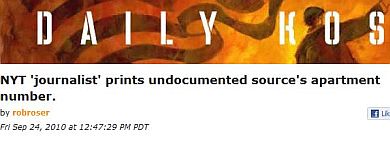
Screenshot detail from DailyKos.com.
The Daily Kos’s “robroser” wrote Sept. 24 noting that the New York Times Kirk Semple published an article that identified anonymous sources – possibly undocumented immigrants.
Journalism ethics and ethicists typically recommend that when anonymous sources are used, journalists offer information about the source to help the public judge the source’s credibility and motives — especially considering the public doesn’t know sources’ names.
But, despite advocating for offering more information about a source than the source just wanted to be anonymous, fellow journalists ordinarily remind to not publish identifying details.
Not so in this case, “robroser” points out.
Kirk Semple’s Sept. 22 article explaining that “Mexican New Yorkers are steady force in workplace” went so far as to give information about where his sources lived and worked. Semple’s article is part of a series titled “Now Arriving” about Mexican immigrants in New York City.
Semple only named his Mexican sources by their first name – presumably their real first names (he does not say).
But, he further described where his sources lived, naming the neighborhood and street his possibly illegal immigrant sources reside.
In fact, Semple was so specific, he reported how many apartments there were in the building, how many people lived with his sources and how old his sources are.
To further help ID his sources, Semple’s story was accompanied by an image of two of his sources turned at their sides in their kitchen. Another image shows a source at his workplace – a grocery store.
A quick Google search narrows down the possible work places for one source to a handful of supermarkets. A glance at a map of Brooklyn indicates that Semple’s neighborhood description only covers a few blocks.
For readers (or authorities) curious about his sources’ identity, Semple added that his Mexican tenant sources “asked that their last names be withheld because they feared being fired or deported.”
Latina Lista’s publisher Marisa Treviño wrote about the issue Sept. 23.
“From a journalistic standpoint, the question that needs to be asked is: Was it necessary to give the apt. number of this guy, who by all accounts from the story is a hard worker? What value did it add for the reader? Was it information that was vital for the telling of this particular story?
“Common sense will say no. Unfortunately, the revelation of what is really delicate information for someone who only wants to use his first name is a violation of his trust with the reporter and journalists in general,” Treviño wrote. Because The Times’ article identified so much information about the likely undocumented immigrants, she further considered that other journalists might have trouble working with immigrants in the future.
As StinkyJournalism reported in mid-September, an internal New York Times memo leaked to Gawker (anonymously) emphasized the importance of Times’ staffers following its own anonymous source policies.
The memo reminded staffers to explain what the source has been granted anonymity with information to help the public decide the source’s credibility.
“Of course, in all cases we must take care not to inadvertently violate the agreement to protect a source’s identity,” Times standards editor Phil Corbett advised.
iMediaEthics has written to Semple and will update with any response.






Comments Terms and Conditions